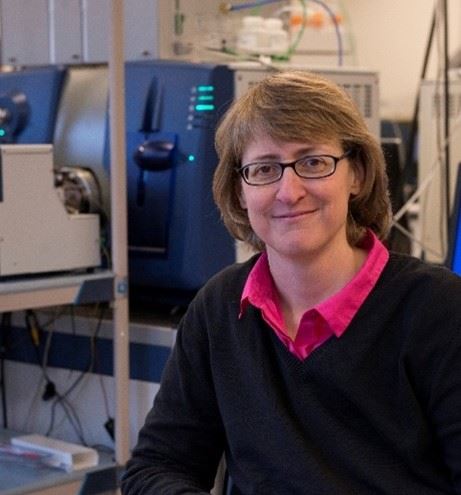By Michelle Hill, QIMR Berghofer Medical Research Institute, Brisbane, Australia, and Stephen Pennington, University College Dublin, Dublin, Ireland.
Developing new therapies for clinical use is a long and costly process. Optimizing dose and schedule in early clinical trials and selecting the right patients for the therapy are two critical aspects for the drug development process. Read how Dr Henrik Neubert (Pfizer), Dr Amanda Paulovich (Fred Hutchinson Cancer Research Center) and Dr Carl Barrett (Astra Zeneca) have used targeted proteomics to facilitate drug development.
In the words of Dr Carl Barrett (Astra Zeneca), “90% of drugs fail for 2 reasons, bad chemistry or bad biology”. Protein technologies have been central in drug development, as most drug targets and their downstream effectors are proteins. In recent years proteins (often antibodies) are also being used as new therapeutics. Recently, proteomics technologies have matured to the stage where they are now sufficiently robust and reproducibly that they being developed into robust high throughput assays. Proteomics can be key to helping to identify bad chemistry (of the drug), and to illuminate bad biology by facilitating pharmacodynamic (PD) and proof of mechanism (POM) studies.
Selecting therapeutic targets with the right properties
 With PhD and postdoctoral training in quantitative protein mass spectrometry, peptide synthesis and MALDI surface chemistry, it was natural for Dr Hendrik Neubert to bring his proteomics knowledge to drug development when he joined Pfizer in 2004. Hendrik now leads a translational biomeasures and protein biomarkers group that develops proteomics assays based on mass spectrometry to measure synthesis rates and concentrations of therapeutic targets as well as their engagement with biotherapeutics. This proteomic data when combined with critical experimental data enables mechanistic modeling to support key drug development program decisions such as the feasibility of modulating the activity of a particular protein target or establishing drug dosing regimens. Hendrik and his team have been particularly influential in the area of immunoaffinity mass spectrometry and worked to robustly position this technology in early clinical trials of Pfizer’s drug candidates. His team was the “terminator” for Pfizer’s osteopontin neutralizing antibody program due to undesirable target properties.
With PhD and postdoctoral training in quantitative protein mass spectrometry, peptide synthesis and MALDI surface chemistry, it was natural for Dr Hendrik Neubert to bring his proteomics knowledge to drug development when he joined Pfizer in 2004. Hendrik now leads a translational biomeasures and protein biomarkers group that develops proteomics assays based on mass spectrometry to measure synthesis rates and concentrations of therapeutic targets as well as their engagement with biotherapeutics. This proteomic data when combined with critical experimental data enables mechanistic modeling to support key drug development program decisions such as the feasibility of modulating the activity of a particular protein target or establishing drug dosing regimens. Hendrik and his team have been particularly influential in the area of immunoaffinity mass spectrometry and worked to robustly position this technology in early clinical trials of Pfizer’s drug candidates. His team was the “terminator” for Pfizer’s osteopontin neutralizing antibody program due to undesirable target properties.
Osteopontin seemed to be a perfect drug target and it was being pursued by several biopharmaceutical companies. It is a circulating protein and pre-clinical studies implicated it in many immune-related diseases, liver fibrosis and cancer. In a cynomolgus monkey model, a neutralizing antibody to osteopontin was effective in ameliorating arthritis. The literature describes a successful phase I trial demonstrating safety and tolerability in men, however, no improvement in disease was observed in a subsequent Phase IIA trial on rheumatoid arthritis.
The Pfizer team was interested in developing a neutralizing antibody against osteopontin for a different indication but before proceeding, Neubert’s team was tasked to investigate the potential PK/PD risks associated with the osteopontin target. The team realized that the half-life of osteopontin in human blood had never been determined before. This is an important parameter for a neutralizing antibody, because if osteopontin protein is quickly eliminated from the body, then the amount and frequency of antibody dosing required for efficacy may not be feasible therapeutically.
Protein half-lives were previously measured by injecting radioactively or fluorescently labelled recombinant protein into preclinical models. Unfortunately, this method is really inadequate for a reliable physiologically relevant half-life measurement as it only measures the rate of elimination, the protein being measured is not endogenous and is typically administered above endogenous concentrations. Most importantly the approach cannot be applied to humans!
With their proteomics expertise, Neubert’s team used longitudinal serum samples from a previously conducted stable-isotope labelled leucine (13C-Leu) pulse-chase study in humans and enriched osteopontin using an anti-osteopontin antibody prior to tryptic digestion. Liquid chromatography-tandem mass spectrometry of a proteotypic peptide with and without 13C-Leu incorporation was used to determine the half-life of osteopontin in human blood from healthy individuals. Surprisingly, with a half-life of around just 20 minutes osteopontin has one of the shortest half-lives Neubert’s team has ever observed for a human protein. Considering the rapid synthesis and clearance from human blood it was evident that the dosing schedule for a neutralizing antibody that would be required was simply not feasible. Hence, Pfizer stopped the discovery project very early before significant further investments were made. Of course, pharma teams all want their therapeutic programs to be successful, but if a drug development program does fail it is ideal it fails early to avoid costly clinical studies so resources can be spent on programs that are more likely to succeed.
Elucidating tumor biology and drug mechanisms of action
Quantifying proteins and protein networks for pharmacodynamic and proof of mechanism studies is critical for translating novel therapies, to confirm the biological mechanisms underlying new compounds and to inform drug dose and scheduling in clinical trials. Immunohistochemistry (IHC) is generally the preferred technology for these studies because it is sensitive, provides biomarker spatial distribution and is semi-quantitative. For clinical implementation, IHC is a well-understood analytical modality. However, IHC is critically dependent on the absolute specificity of individual antibodies, and establishing this specificity is costly in terms of time and resource. As a result, only a handful of fully validated IHC protocols can be developed for each drug project, where the choice of which IHC assays to develop is largely done on the basis of “best educated guess” arising from orthogonal preclinical methods such as Western blotting.
 Adding to the challenge of measuring specific proteins by IHC, it is recognized that proteins act as interconnected networks, and the effects of cancer driver mutations for example spread throughout the networks. Ideally we would have assays to quantify panels of multiple proteins in early phase clinical trials to assess the activity of pathways/networks that determine treatment responses, and this developmental effort is not practical using IHC
Adding to the challenge of measuring specific proteins by IHC, it is recognized that proteins act as interconnected networks, and the effects of cancer driver mutations for example spread throughout the networks. Ideally we would have assays to quantify panels of multiple proteins in early phase clinical trials to assess the activity of pathways/networks that determine treatment responses, and this developmental effort is not practical using IHC
More specific and quantitative “NextGen” proteomic techniques are now starting to be used, exemplified by the stimulating interdisciplinary collaboration between Dr. Carl Barrett (AstraZeneca) and Dr. Amanda Paulovich (Fred Hutchinson Cancer Research Center). Paulovich is a geneticist and oncologist who has run a translational proteomic laboratory at Fred Hutch for the past 17 years. Barrett has a PhD in biophysical chemistry and is VP Translational Sciences Onc iMed at AstraZeneca.
 A recent collaborative project between their teams identified phospho-RAD50 as a novel pharmacodynamic biomarker for inhibitors of DNA damage checkpoint signaling kinases ATM and ATR, which are being tested in clinical trials in a variety of cancers. While pharmacodynamic biomarkers were available, the assays and biomarkers were not ideal.
A recent collaborative project between their teams identified phospho-RAD50 as a novel pharmacodynamic biomarker for inhibitors of DNA damage checkpoint signaling kinases ATM and ATR, which are being tested in clinical trials in a variety of cancers. While pharmacodynamic biomarkers were available, the assays and biomarkers were not ideal.
Paulovich’s lab developed a multiplexed immuno-multiple reaction monitoring mass spectrometry assay to measure proteins and phosphoproteins in the signaling cascade downstream of the DNA damage checkpoint. The team used this targeted mass spectrometry-based assay panel to identify Ser635-phosphorylated RAD50 as a novel pharmacodynamic biomarker of ATR and ATM kinase inhibitor pharmacology. The pRad50 biomarker was further validated by Barret’s team using two preclinical xenograft models and using archived human tumor material. Together this supported clinical utilization of pRAD50 as a biomarker to probe clinical pharmacokinetic/pharmacodynamic relationships, thereby informing recommended Phase 2 dose/schedule.
Towards broader clinical testing
The productive interdisciplinary academia-pharma collaboration between Barrett and Paulovich has propelled immuno-MRM assays from research to established Clinical Laboratory Improvement Amendments (CLIA)/clinical grade assays, suitable for clinical trials to facilitate drug development. Paulovich’s team has developed >1,400 targeted mass spectrometry-based assays, which her laboratory runs in its recently-established CLIA environment. CLIA establishes the quality laboratory framework for human diagnostic testing, so Paulovich is taking targeted proteomics assays a step closer to clinical use.
Barrett and Paulovich are actively involved with the National Cancer Institute’s
Clinical Proteomic Tumor Analysis Consortium (CPTAC), a national effort to accelerate the understanding of the molecular basis of cancer through the application of large-scale proteome and genome analysis, or proteogenomics. A major goal of CPTAC is to translate proteomic technologies into clinical use. To facilitate distribution and uptake of proteomic technologies by the community, CPTAC has developed public resources, such as the
CPTAC Assay Portal and the
CPTAC Antibody Portal. One of the CPTAC antibodies is incorporated into a clinical
thyroglobulin mass spectrometry test, which is used for thyroid cancer patients with autoantibodies that interfere with widely used immunoassays.
The specificity, sensitivity and robustness of targeted proteomics assays make them highly attractive for clinical trials where thousands of samples require analysis using validated methods. Indeed, Neubert’s team are now using targeted proteomics assays not only to assess the effect of biotherapeutics but increasingly also to examine transgene protein expression in gene therapy studies, both preclinically and clinically.
Interested to know more? Register for HUPO Connect 2020 to hear exciting scientific presentations from both Hendrik Neubert and Amanda Paulovich as well as other global leaders.


.png)